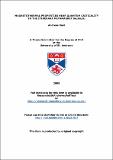Files in this item
Magnetothermal properties near quantum criticality in the itinerant metamagnet Sr₃Ru₂O₇
Item metadata
| dc.contributor.advisor | Mackenzie, Andrew | |
| dc.contributor.advisor | Grigera, Santiago A. | |
| dc.contributor.author | Rost, Andreas W. | |
| dc.coverage.spatial | 164 | en_US |
| dc.date.accessioned | 2009-12-16T11:49:56Z | |
| dc.date.available | 2009-12-16T11:49:56Z | |
| dc.date.issued | 2009-06-26 | |
| dc.identifier.uri | https://hdl.handle.net/10023/837 | |
| dc.description.abstract | The search for novel quantum states is a fundamental theme in condensed matter physics. The almost boundless number of possible materials and complexity of the theory of electrons in solids make this both an experimentally and theoretically exciting and challenging research field. Particularly, the concept of quantum criticality resulted in a range of discoveries of novel quantum phases, which can become thermodynamically stable in the vicinity of a second order phase transition at zero temperature due to the existence of quantum critical fluctuations. One of the materials in which a novel quantum phase is believed to form close to a proposed quantum critical point is Sr₃Ru₂O₇. In this quasi-two-dimensional metal, the critical end point of a line of metamagnetic first order phase transitions can be suppressed towards zero temperature, theoretically leading to a quantum critical end point. Before reaching absolute zero, one experimentally observes the formation of an anomalous phase region, which has unusual ‘nematic-like’ transport properties. In this thesis magnetocaloric effect and specific heat measurements are used to systematically study the entropy of Sr₃Ru₂O₇ as a function of both magnetic field and temperature. It is shown that the boundaries of the anomalous phase region are consistent with true thermodynamic equilibrium phase transitions, separating the novel quantum phase from the surrounding ‘normal’ states. The anomalous phase is found to have a higher entropy than the low and high field states as well as a temperature dependence of the specific heat which deviates from standard Fermi liquid predictions. Furthermore, it is shown that the entropy in the surrounding ‘normal’ states increases significantly towards the metamagnetic region. In combination with data from other experiments it is concluded that these changes in entropy are most likely caused by many body effects related to the underlying quantum phase transition. | en_US |
| dc.language.iso | en | en_US |
| dc.publisher | University of St Andrews | |
| dc.subject | Physics | en_US |
| dc.subject | Condensed matter | en_US |
| dc.subject | Specific heat | en_US |
| dc.subject | Magnetocaloric effect | en_US |
| dc.subject | Quantum criticality | en_US |
| dc.subject | Sr₃Ru₂O₇ | en_US |
| dc.subject | Strongly correlated electron systems | en_US |
| dc.subject.lcc | QC173.458M33R7 | |
| dc.subject.lcsh | Condensed matter--Magnetic properties | en |
| dc.subject.lcsh | Condensed matter--Thermal properties | en |
| dc.subject.lcsh | Ruthenium oxide superconductors | en |
| dc.title | Magnetothermal properties near quantum criticality in the itinerant metamagnet Sr₃Ru₂O₇ | en_US |
| dc.type | Thesis | en_US |
| dc.contributor.sponsor | SUPA Graduate School | en_US |
| dc.contributor.sponsor | Engineering and Physical Sciences Research Council (EPSRC) | en_US |
| dc.type.qualificationlevel | Doctoral | en_US |
| dc.type.qualificationname | PhD Doctor of Philosophy | en_US |
| dc.publisher.institution | The University of St Andrews | en_US |
| dc.publisher.department | School of Physics and Astronomy | en_US |
This item appears in the following Collection(s)
Items in the St Andrews Research Repository are protected by copyright, with all rights reserved, unless otherwise indicated.

